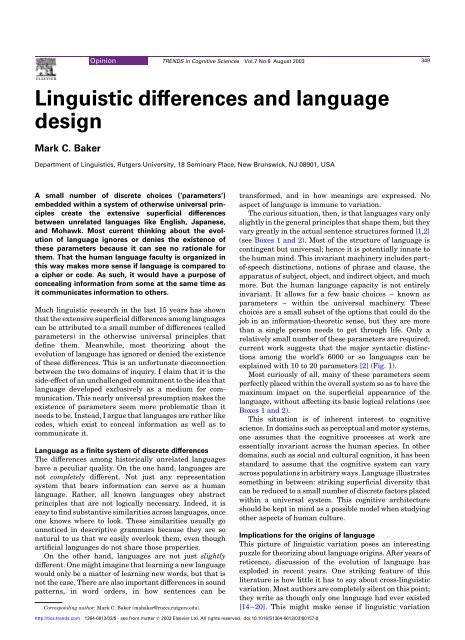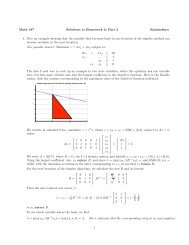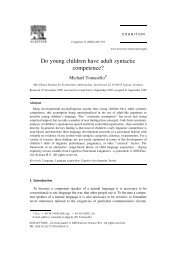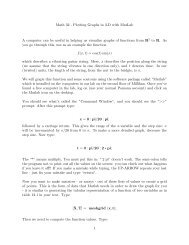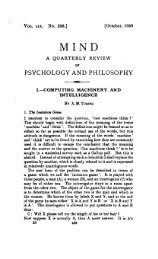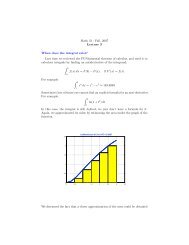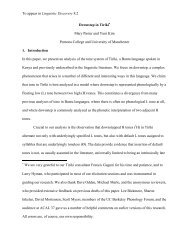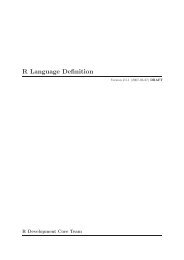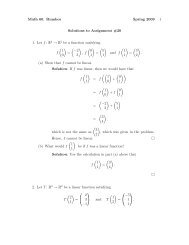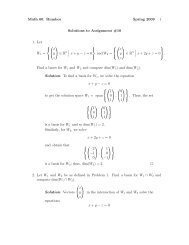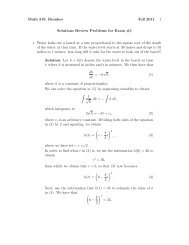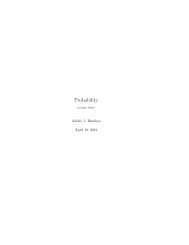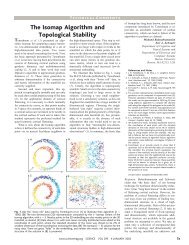Linguistic differences and language design
Linguistic differences and language design
Linguistic differences and language design
Create successful ePaper yourself
Turn your PDF publications into a flip-book with our unique Google optimized e-Paper software.
Opinion TRENDS in Cognitive Sciences Vol.7 No.8 August 2003 349<strong>Linguistic</strong> <strong>differences</strong> <strong>and</strong> <strong>language</strong><strong>design</strong>Mark C. BakerDepartment of <strong>Linguistic</strong>s, Rutgers University, 18 Seminary Place, New Brunswick, NJ 08901, USAA small number of discrete choices (‘parameters’)embedded within a system of otherwise universal principlescreate the extensive superficial <strong>differences</strong>between unrelated <strong>language</strong>s like English, Japanese,<strong>and</strong> Mohawk. Most current thinking about the evolutionof <strong>language</strong> ignores or denies the existence ofthese parameters because it can see no rationale forthem. That the human <strong>language</strong> faculty is organized inthis way makes more sense if <strong>language</strong> is compared toa cipher or code. As such, it would have a purpose ofconcealing information from some at the same time asit communicates information to others.Much linguistic research in the last 15 years has shownthat the extensive superficial <strong>differences</strong> among <strong>language</strong>scan be attributed to a small number of <strong>differences</strong> (calledparameters) in the otherwise universal principles thatdefine them. Meanwhile, most theorizing about theevolution of <strong>language</strong> has ignored or denied the existenceof these <strong>differences</strong>. This is an unfortunate disconnectionbetween the two domains of inquiry. I claim that it is theside-effect of an unchallenged commitment to the idea that<strong>language</strong> developed exclusively as a medium for communication.This nearly universal presumption makes theexistence of parameters seem more problematic than itneeds to be. Instead, I argue that <strong>language</strong>s are rather likecodes, which exist to conceal information as well as tocommunicate it.Language as a finite system of discrete <strong>differences</strong>The <strong>differences</strong> among historically unrelated <strong>language</strong>shave a peculiar quality. On the one h<strong>and</strong>, <strong>language</strong>s arenot completely different. Not just any representationsystem that bears information can serve as a human<strong>language</strong>. Rather, all known <strong>language</strong>s obey abstractprinciples that are not logically necessary. Indeed, it iseasy to find substantive similarities across <strong>language</strong>s, onceone knows where to look. These similarities usually gounnoticed in descriptive grammars because they are sonatural to us that we easily overlook them, even thoughartificial <strong>language</strong>s do not share those properties.On the other h<strong>and</strong>, <strong>language</strong>s are not just slightlydifferent. One might imagine that learning a new <strong>language</strong>would only be a matter of learning new words, but that isnot the case. There are also important <strong>differences</strong> in soundpatterns, in word orders, in how sentences can beCorresponding author: Mark C. Baker (mabaker@ruccs.rutgers.edu).transformed, <strong>and</strong> in how meanings are expressed. Noaspect of <strong>language</strong> is immune to variation.The curious situation, then, is that <strong>language</strong>s vary onlyslightly in the general principles that shape them, but theyvary greatly in the actual sentence structures formed [1,2](see Boxes 1 <strong>and</strong> 2). Most of the structure of <strong>language</strong> iscontingent but universal; hence it is potentially innate tothe human mind. This invariant machinery includes partof-speechdistinctions, notions of phrase <strong>and</strong> clause, theapparatus of subject, object, <strong>and</strong> indirect object, <strong>and</strong> muchmore. But the human <strong>language</strong> capacity is not entirelyinvariant. It allows for a few basic choices – known asparameters – within the universal machinery. Thesechoices are a small subset of the options that could do thejob in an information-theoretic sense, but they are morethan a single person needs to get through life. Only arelatively small number of these parameters are required;current work suggests that the major syntactic distinctionsamong the world’s 6000 or so <strong>language</strong>s can beexplained with 10 to 20 parameters [2] (Fig. 1).Most curiously of all, many of these parameters seemperfectly placed within the overall system so as to have themaximum impact on the superficial appearance of the<strong>language</strong>, without affecting its basic logical relations (seeBoxes 1 <strong>and</strong> 2).This situation is of inherent interest to cognitivescience. In domains such as perceptual <strong>and</strong> motor systems,one assumes that the cognitive processes at work areessentially invariant across the human species. In otherdomains, such as social <strong>and</strong> cultural cognition, it has beenst<strong>and</strong>ard to assume that the cognitive system can varyacross populations in arbitrary ways. Language illustratessomething in between: striking superficial diversity thatcan be reduced to a small number of discrete factors placedwithin a universal system. This cognitive architectureshould be kept in mind as a possible model when studyingother aspects of human culture.Implications for the origins of <strong>language</strong>This picture of linguistic variation poses an interestingpuzzle for theorizing about <strong>language</strong> origins. After years ofreticence, discussion of the evolution of <strong>language</strong> hasexploded in recent years. One striking feature of thisliterature is how little it has to say about cross-linguisticvariation. Most authors are completely silent on this point;they write as though only one <strong>language</strong> had ever existed[14–20]. This might make sense if linguistic variationhttp://tics.trends.com 1364-6613/03/$ - see front matter q 2003 Elsevier Ltd. All rights reserved. doi:10.1016/S1364-6613(03)00157-8
Opinion TRENDS in Cognitive Sciences Vol.7 No.8 August 2003 351Box 2. Comparing Mohawk <strong>and</strong> EnglishMohawk is a ‘polysynthetic’ <strong>language</strong>, meaning that sentencestructures tend to be short <strong>and</strong> fluid, but words are complex <strong>and</strong>rigidly structured [10,11]. Sentences (2) <strong>and</strong> (3) illustrate thefluidity; they have different word orders, but express the sameevent.Rukwe’ wa-sh-ako-hsir-u ne owira’a. (2)(man past-he-her-blanket-gave the baby)‘The man gave the baby a blanket.’Owira’a wa-sh-ako-hsir-u ne rukwe’. (3)(baby past-he-her-blanket-gave the man)‘The man gave the baby a blanket.’Mohawk differs from English (<strong>and</strong> Japanese) in this respect, wherechanges in word order express major changes in meaning (compare‘Man bites dog’ with ‘Dog bites man’).Smallchangesintheverbdo,however,havealargeimpactonmeaningin Mohawk. Sentence (4) shows that changing the prefixes on the verb isenough to reverse the meaning even with word order held constant.Rukwe’ wa-h-uwa-hsir-u ne owira’a. (4)(man past-him-she-blanket-gave the baby)‘The baby gave the man a blanket.’Moreover, the thing given in these sentences is not expressed as aseparate noun phrase; it is ‘incorporated’ into the verb, forming a kindof compound word. Sentence (5) shows that the incorporated nouncan only be understood as the thing given, never as the giver or therecipient.‘Rukwe’ wa-ha-wir-u ne ashire’. (5)(man past-he-it-baby-gave the blanket)‘The man gave the baby to the blanket.’The unifying property of Mohawk is the requirement that everyparticipant of an event must be expressed in the verb that names theevent, either as a pronoun-like agreement prefix, or as an incorporatednoun root [11]. A Mohawk sentence without these features isungrammatical (6):‘Rukwe’ wa’-u ne owira’a ne ashire’ (6)(man past-give the baby the blanket)‘The man gave the baby the blanket.’No such requirement holds in English. ‘Mixed’ <strong>language</strong>s that require(say) the object to be expressed on the verb <strong>and</strong> the subject not to be, arerare compared with the Mohawk <strong>and</strong> English types.Apart from this parameter, Mohawk <strong>and</strong> English have importantsimilarities. In both <strong>language</strong>s, the verb meaning ‘give’ names anevent involving three participants, a subject (the giver), an object(the given thing), <strong>and</strong> an indirect object (the receiver). All threeparticipants must be expressed in both <strong>language</strong>s. In English as inMohawk, a noun that is incorporated into a compound can onlyexpress the thing given: English has the compound form giftgiving,butbaby-giving would only have the unlikely meaning thatpeople give away their babies [12,13]. The one difference betweenthe two is an easily stated parameter that regulates howparticipants are expressed. But this simple parameter has a largeoverall effect, because it applies to every phrase in every sentenceof the <strong>language</strong>.human <strong>language</strong> faculty, but rather a kind of evolutionaryaccident, as suggested by Pinker <strong>and</strong> others [25–27]. Theclaim is that evolution has fixed many properties of human<strong>language</strong>, but not all of them. Once the innate endowmentbecame rich enough to make learning a complex <strong>language</strong>reasonably reliable, there was little selectional pressure tokeep elaborating it until all grammatical properties weredetermined. ‘Parameters’ are those grammatical pointsthat are still left open by the innate endowment.Although there might be no direct refutation of thisview, I find it unsatisfying, given the quality of thelinguistic <strong>differences</strong> we know about. The known parametersdo not seem like minor quirks at the edges of<strong>language</strong> that were not worth worrying about. Rather,they seem like gadgets put close to the heart of <strong>language</strong>,exactly where they will have maximum impact on surfaceorders without changing underlying logical relationships.Given this, we should consider the possibility that parametersare a <strong>design</strong> feature of the <strong>language</strong> faculty after all.Languages as codesMost researchers take it for granted that the evolutionarypurpose of <strong>language</strong> is to provide a way of communicatingcomplex propositional information to kin <strong>and</strong> collaborators.From this point of view, the possibility of radicallydifferent <strong>language</strong>s is perplexing. But this is a theoreticalassumption, not an established empirical result.Suppose that the <strong>language</strong> faculty has a concealingfunction as well as a revealing function. Our <strong>language</strong>faculty could have the purpose of communicating complexpropositional information to members of our group whileconcealing it from members of other groups. Manyproducts of human engineering have been <strong>design</strong>ed tofulfill exactly this purpose – namely codes <strong>and</strong> ciphers.Ciphers have a common structure: they consist of apublicly-known encryption algorithm that defines a familyof ciphers <strong>and</strong> a secret ‘key’ that defines a particular cipher[28]. The innate endowment for <strong>language</strong> has a similarstructure: the universal principles correspond to thegeneral encryption algorithm, <strong>and</strong> the particular parametersettings correspond to the key. There are alsointriguing correspondences of detail between particularciphers <strong>and</strong> the specific ways <strong>language</strong>s differ from oneanother (see Box 3). This shift of perspective makes senseof the fact that many parameters seem perfectly <strong>design</strong>edto give <strong>language</strong>s very different ‘looks’ without affectingthe fundamental content expressed. That is the nature of agood cipher.We know that natural <strong>language</strong>s can make excellentcodes; this was proven by the Navajo Code Talkers ofWorld War II, whose native <strong>language</strong> was never cracked bycryptographers [29,30]. Could natural <strong>language</strong>s havefunctioned in a similar way in traditional societies, beforeradios <strong>and</strong> intercontinental transportation? I do not havethe anthropological expertise to answer this question fully,but some broad outlines are clear. People throughout theworld have lived in a state of more or less perpetualwarfare, <strong>and</strong> where possible they prefer to fight againstpeople from a different linguistic group. Furthermore,successful warfare in ‘primitive’ societies depended heavilyon group coordination combined with secrecy <strong>and</strong>treachery [31]. Thus, the boundary conditions under whichone can imagine an encoding function for human <strong>language</strong>being useful were present.http://tics.trends.com
352Opinion TRENDS in Cognitive Sciences Vol.7 No.8 August 2003PolysynthesisnoHead directionality/Optional polysynthesisyesAdjective neutralizeFirst/no First/yes last/yes last/noverbnounSubject sideChichewaSelayareseSlaveQuechuaErgativecaseMohawkWarlpiribeginningendAccusErgVerb attractionyesnoTzotzilMalagasyTopic prominentyesnoGreenl<strong>and</strong>icDyirbalSubject placement Serial verbs JapaneseChoctawlow highno yesTurkishMalayalamWelshZapotecPro dropEnglishIndonesianEdoKhmernoyesFrenchSpanishRomanianTRENDS in Cognitive SciencesFig. 1. The parameter hierarchy. This is a systematic representation of some major parameters that distinguish <strong>language</strong>s (shown in violet). Each branch point is labeledwith the name of one or more parameters; below each point are lower-level parameters that depend on them. The Polysynthesis parameter at the top of the hierarchy is theparameter that distinguishes Mohawk from English in Box 2. The Head Directionality parameter one step down is the parameter that distinguishes Japanese from English.At the bottom of the diagram are some historically unrelated <strong>language</strong>s that are syntactically similar as a result of having the same settings for these parameters.Box 3. Comparing <strong>language</strong> <strong>differences</strong> to 16th century cryptographyClaims that a biological system has a particular function are oftenreinforced by comparing it to products of human engineering that havethat function. When the two have detailed structural similarities, theclaim that they have similar functions gains support, a classic examplebeing the comparison between the vertebrate eye <strong>and</strong> a camera. Theways human <strong>language</strong>s differ can be compared to cryptographictechniques of the 16th century (see Table I). Sixteenth centurycryptographers used a variety of techniques: they both replaced <strong>and</strong>rearranged symbols in systematic ways, <strong>and</strong> they performed thesetransformations both at the level of letters <strong>and</strong> at the level of words <strong>and</strong>phrases [26]. This layered complexity evolved over time with the explicitpurpose of defeating particular code-breaking strategies (such asfrequency analysis). Natural <strong>language</strong>s also differ from one another inways that show layered complexity, using substitution <strong>and</strong> rearrangementat multiple levels. Many of the specific tricks of early cryptographershave striking analogies in natural <strong>language</strong>. This givescredence to the notion that natural <strong>language</strong>s have the same concealingfunction as man-made ciphers.Table I. Similarities between cryptographic methods <strong>and</strong> natural <strong>language</strong>sCryptographic techniqueNatural <strong>language</strong>Steganography (hiding the message)Use of phonetic distinctions that are imperceptible to speakers of other<strong>language</strong>sLetter for letter substitution ciphersUse of different sound systemsCode expressions that st<strong>and</strong> for entire words <strong>and</strong> phrasesSaussurean arbitrariness (use of arbitrary sounds to express a concept)Use of homophones (different code symbols for the same letter) Allophonic variation (different pronunciations with no associatedmeaning difference)Use of nulls (symbols added that do not st<strong>and</strong> for any letter) Use of functional particles with no truth-conditional meaningRemoval of spaces between wordsPhonological joining of words by rules of ‘external s<strong>and</strong>hi’Transposition ciphers (systematic scrambling of words <strong>and</strong> letters) Word order parameters (see Boxes 1 <strong>and</strong> 2)http://tics.trends.com
Opinion TRENDS in Cognitive Sciences Vol.7 No.8 August 2003 353Some researchers dismiss the idea that linguistic<strong>differences</strong> have a function out of h<strong>and</strong>. But we shouldalso be wary of evolutionary psychological reasoning if itleads us to downplay what is, because of unprovableassumptions about what must have been. The use of<strong>language</strong> in early human societies is not observable, <strong>and</strong>yet the reality of linguistic variation of a particular kind is,so we should focus on that. There are, after all, plenty ofunsolved questions about human cognition: intentionality,free will, a priori knowledge, abductive reasoning, <strong>and</strong> soon [32,33]. Many of these are clearly related to <strong>language</strong>[2]. We therefore need to remain open to new insights fromoutside the familiar range of assumptions.ConclusionThe extensive <strong>differences</strong> among human <strong>language</strong>s can beattributed to a small number of discrete <strong>differences</strong> in theunderlying rule system, known as parameters. In thisrespect, <strong>language</strong>s are similar to artificial codes,suggesting that <strong>language</strong> developed to prevent communicationas well as to permit communication. Furtherresearch is needed to complete the parametric account ofhow <strong>language</strong>s differ, <strong>and</strong> to develop theories of the originsof <strong>language</strong> that explain not only the existence of human<strong>language</strong>s, but also how they can differ so systematically.In particular, we need to explore alternatives to thesimplistic assumption that <strong>language</strong> exists only forcommunication.References1 Chomsky, N. (1981) Lectures on Government <strong>and</strong> Binding, Foris2 Baker, M. (2001) The Atoms of Language, Basic Books3 Kuno, S. (1973) The Structure of the Japanese Language, MIT Press4 Stowell, T. (1981) Origins of Phrase Structure, MIT5 Dryer, M. (1992) The Greenbergian word order correlations. Language68, 81–1386 Greenberg, J. (1963) Universals of Language, MIT Press7 Tomlin, R. (1986) Basic Word Order: Functional Principles,CroomHelm8 Koopman, H. (1984) The Syntax of Verbs, Foris9 K<strong>and</strong>ybowicz, J. <strong>and</strong> Baker, M. On directionality <strong>and</strong> the structure ofthe verb phrase. Syntax (in press)10 Mithun, M. <strong>and</strong> Chafe, W. (1979) Recapturing the Mohawk <strong>language</strong>.In Languages <strong>and</strong> Their Status (Shopen, T., ed.), pp. 3–34, WinthropPress11 Baker, M. (1996) The Polysynthesis Parameter, Oxford UniversityPress12 Mithun, M. (1984) The evolution of noun incorporation. Language 60,847–89313 Baker, M. (1988) Incorporation: a Theory of Grammatical FunctionChanging, University of Chicago Press14 Bickerton, D. (1990) Language <strong>and</strong> Species, University of ChicagoPress15 Bickerton, D. (1995) Language <strong>and</strong> Human Behavior, University ofWashington Press16 Carstairs-McCarthy, A. (1999) The Origins of Complex Language,Oxford University Press17 Lieberman, P. (1985) The Biology <strong>and</strong> Evolution of Language, HarvardUniversity Press18 Lieberman, P. (1999) Eve Spoke: Human Language <strong>and</strong> HumanEvolution, W.W. Norton19 Newmeyer, F. (1991) Functional explanation in linguistics <strong>and</strong> theorigins of <strong>language</strong>. Lang. Commun. 11, 3–11420 Jackendoff, R. (1999) Possible stages in the evolution of the <strong>language</strong>capacity. Trends Cogn. Sci. 3, 272–27921 Gallistel, C.R. (1995) Symbolic processes in the brain: the case of insectnavigation. In An Invitation to Cognitive Science (Vol. 3) (Smith, E. <strong>and</strong>Osherson, D., eds), pp. 1–51, MIT Press22 Aitchison, J. (1996) The Seeds of Speech: Language Origin <strong>and</strong>Evolution, Cambridge University Press23 Nowak, M. et al. (2001) Evolution of Universal Grammar. Science 291,114 – 11824 Nowak, M. <strong>and</strong> Komarova, N. (2001) Towards an evolutionary theoryof <strong>language</strong>. Trends Cogn. Sci. 5, 288–29525 Pinker, S. <strong>and</strong> Bloom, P. (1990) Natural <strong>language</strong> <strong>and</strong> naturalselection. Behav. Brain Sci. 13, 707–78426 Pinker, S. <strong>and</strong> Bloom, P. (1994) Humans did not evolve from bats.Behav. Brain Sci. 17, 183–18527 Newmeyer, F. (1998) Language Form <strong>and</strong> Language Function, MITPress28 Singh, S. (1999) The Code Book, Doubleday29 Paul, D. (1973) The Navajo Code Talkers, Dorrance & Company30 Bernstein, A. (1991) American Indians <strong>and</strong> World War II, University ofOklahoma Press31 Divale, W. (1973) Warfare in Primitive Societies, Clio Press32 McGinn, C. (1993) Problems in Philosophy: The Limits of Inquiry,Blackwell33 Fodor, J. (2000) The Mind Doesn’t Work That Way, MIT PressTICS Book ReviewsWe aim to review the best of the new books in Cognitive Science in TICS.Our book reviews are styled like short opinion pieces or mini-reviews of a subject area, with the aim of providing readers with morein-depth analysis. As well as critically appraising important new texts in the field, the authors of reviews will be encouraged to usethe book as a framework for wider discussion.Publishers: monographs <strong>and</strong> edited volumes (but not undergraduate textbooks) will be considered for review in Trends in CognitiveSciences. Please send us advance e-mails of forthcoming titles <strong>and</strong> copies of books you would like to be reviewed to the BookReview Editor at the address below.Trends in Cognitive SciencesElsevier London, 84 Theobald’s Road, London WC1X 8RR, UK.e-mail: tics@current-trends.comhttp://tics.trends.com


